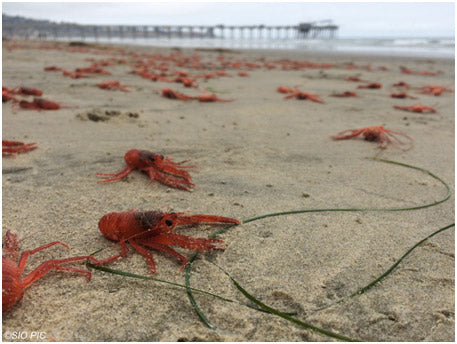Cali Paddler is stoked to have paddlers who work in the marine-science fields share with us their knowledge so we can learn, and become more aware of the waters we enjoy. Thank you to fellow paddler Linsey Sala of Scripps Institution of Oceanography for sharing with us about the Tuna Crabs that have recently been sharing the waters and beaches in Southern California in very big numbers.
 If you have been paddling, swimming, surfing, or beach combing with your pup you have probably noticed the periodic presence of a beautiful bright red crustacean inhabiting our local waters these last two years – the pelagic red crab. The scientific name of this crustacean is Pleuroncodes planipes. This species is well known off the west coast of Baja California, in the Gulf of CA, and the CA Current with its center of distribution off central and southern Baja CA. This red crab is unique because it can live its entire life cycle in the water column (surface to seafloor), from larvae to adulthood. It starts off as a microscopic free drifting larva living close to the surface, feeding on microscopic single celled algae called phytoplankton. As they get older and bigger, they will continue to graze on phytoplankton but can also eat small planktonic animals called zooplankton like krill and copepods.
If you have been paddling, swimming, surfing, or beach combing with your pup you have probably noticed the periodic presence of a beautiful bright red crustacean inhabiting our local waters these last two years – the pelagic red crab. The scientific name of this crustacean is Pleuroncodes planipes. This species is well known off the west coast of Baja California, in the Gulf of CA, and the CA Current with its center of distribution off central and southern Baja CA. This red crab is unique because it can live its entire life cycle in the water column (surface to seafloor), from larvae to adulthood. It starts off as a microscopic free drifting larva living close to the surface, feeding on microscopic single celled algae called phytoplankton. As they get older and bigger, they will continue to graze on phytoplankton but can also eat small planktonic animals called zooplankton like krill and copepods.
They will lead an almost exclusive free-swimming lifestyle for about the first year. Into the second year of life they will spend time on the seafloor, but still possess the ability to make vertical excursions to the surface to feed and release their young in the productive surface layer of the ocean. These crabs are very well adapted for spending most of their lives swimming with short squatty abdomens, very long legs and pincers. Check out how they spread out those long appendages to increase drag and then pull all of them streamline quickly to initiate swift swimming maneuvers while you’re out on the water.

Another common name for this species is the tuna crab, because several species of tuna love to feed on them along with other larger fish, squid, sea birds, porpoises, and even blue whales. In fact, we have had some pretty large blue fin tuna being caught off San Diego this past month heavily preying upon these crabs. A friend and colleague of mine who is a Fisheries Biologist at NOAA in La Jolla is looking to collect the carcasses including heads, gonads, and stomachs from larger fish 75-250lbs. to answer important questions about their age, reproduction, migrations, and long term diets. Read more here on how to contact him and donate your blue fin tuna carcass: http://www.bdoutdoors.com/forums/threads/call-for-bluefin-tuna-carcasses-and-late-report-from-the-371.628039/.
Because these red tuna crabs spend so much time swimming: winds, waves, currents and tides play an important role in their movements and distribution. Historically, during warmer water events especially stronger El Niño’s we have seen higher numbers of the tuna crab in Southern California waters and even as far north as Monterey Bay. When conditions favor currents flowing northward to prevail due to changes in the surface winds and water movement associated with these types of climatic events these animals can be swept further northward. They can occur in vast pelagic swarms and beach strandings are common in Baja CA. The habitat here can be suitable enough for them to continue to live locally and in the past they have been known to inhabit these waters for several years after the initial onset of El Niño. If you catch a swarm of pelagic red crab happily creating a feeding current by swimming upside down at the surface, moving their hairy mouth parts, legs, and pincers as you glide past on your OC1 or SUP, consider yourself lucky to have encountered one of many amazing free swimming invertebrates inhabiting our unique environment. This is one of many interesting drifters that have graced our surface waters in recent years. Keep your eyes wide open, and your heart full of passion for what you love. Stay safe out there and happy paddling!

![]() Team Writer Linsey Sala - My name is Linsey Sala, Invertebrate Taxonomist, Museum Scientist and Manager of the Pelagic Invertebrates Oceanographic Collection at Scripps Institution of Oceanography at UCSD in La Jolla, and fellow paddler from Hanohano Outrigger Canoe Club in SCORA.
Team Writer Linsey Sala - My name is Linsey Sala, Invertebrate Taxonomist, Museum Scientist and Manager of the Pelagic Invertebrates Oceanographic Collection at Scripps Institution of Oceanography at UCSD in La Jolla, and fellow paddler from Hanohano Outrigger Canoe Club in SCORA.
















ray hojnacki - October 01, 2024
Hi Linsey Saya, I saw a program on TV about tuna crabs. One question, when they start to swim, they fold everything in front of them and swim backwards. Their eyes are in back of them, how do they see (or know) where they are going ? Thanks for your answer.